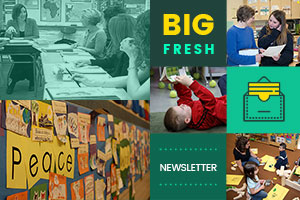The mere brute pleasure of reading – the sort of pleasure a cow must have in grazing.
Lord Chesterfield
Last month I visited reading workshop in Katrina Edwards’ first-grade classroom in West Linn, Oregon. It was early in the year, and students were honing their partner-reading skills. After 20 minutes of independent reading, the children paired up with their designated partners. Melinda and Jared sat 10 feet from me, side by side. Melinda opened her book and the conversation went something like this:
Melinda: Okay, so. . .
Jared: MOOOOOOOOOOOOOOOOOOOOOO!
Melinda: No, wait . . .
Jared: MOOOOOOOOOOOOOOOOOOOOOO!
Melinda jumped out of her seat, threw Jared a “oh you are so in trouble buddy” glare, and marched over to Katrina on the other side of the room. I couldn’t hear what she said to her teacher, but I could imagine.
Is it terrible that I live for these moments when I am observing in classrooms? I love seeing the amazing things kids can do. And I love even more seeing the amazing things teachers do when kids behave in unexpected ways.
Katrina walked over to Jared and said, “Come with me. I want to look at some of our friends’ reading partnerships that are strong and take some pictures, and I want you to come with me.” Katrina walked across the room, and as she moved between clusters of students, she gathered up a couple more kids who weren’t focused in their partnerships, becoming a sort of Pied Piper of Problem Children. As she made her way to the center of the classroom, she stopped with the group at different reading pairs, asking the young readers at work what they were talking about and how they decided who went first in the conversation, all the while snapping pictures with her iPad as the group watched the partners in action. After a few minutes of quietly observing and talking to different pairs of students, she turned to each child in her walking group, looked them in the eye, and asked them individually,
“What did you notice?”
“What were your friends doing in their reading partnerships? How did they help each other?”
“What problem were you having in your partnership? How might you solve it?”
The entire stroll through the classroom collecting students, observing three different successful student partnerships, and debriefing with each struggling child took only six minutes to complete.
I thought of what Katrina didn’t do. She didn’t sit down with Jared and ask him why he was mooing instead of talking with Melinda. (Who knows? Maybe he was reading about cows? Maybe he thought he was a cow? Maybe he’d put too much milk on his cereal? Does it really matter?) She didn’t tell Jared how he was supposed to behave. She didn’t threaten him that he had better straighten up and fly right OR ELSE. Instead, she let his classmates show him and others with similar needs what a successful reading partnership looks like.
We talk about “showing, not telling” all the time in writing instruction. But the principle is just as useful in helping children monitor their reading and writing in classroom communities. And the showing not telling does double duty – many successful children may not be fully conscious of their skills, but their metacognitive awareness is built as those skills are noted, recorded, and reflected upon by peers.
It’s hard for any teacher to see a child who is mooing instead of reading and conversing as a gift, especially when you’ve got a visitor in your classroom eagerly scribbling away in her notebook, writing down your every move. But watching Katrina improvise her way through the Case of the Mooing Reading Partner was the best present I’ve received in weeks.
This week we consider student engagement and stamina. Plus more as always — enjoy!
Brenda Power
Founder, Choice Literacy
Free for All
[For sneak peeks at our upcoming features, quotes and extra links, follow Choice Literacy on Twitter: @ChoiceLiteracy or Facebook: http://www.facebook.com/ChoiceLiteracy or Pinterest: http://pinterest.com/choiceliteracy/]
Are the words stamina and engagement synonymous? Cathy Mere defines the terms by observing her first graders:
http://www.choiceliteracy.com/articles-detail-view.php?id=1889
Stamina is a term we use often in literacy instruction, but it can be tricky for students and teachers to define in classroom contexts. Heather Rader looks at the specific attributes of writing stamina, as well as how to model it for students:
http://www.choiceliteracy.com/articles-detail-view.php?id=970
Melissa Taylor has tips for parents when reading is too “sitty” for active kids — these strategies can help children build reading interest and stamina:
http://www.readingrockets.org/article/what-do-when-reading-too-sitty
For Members Only
“Why do you always say ‘Happy reading!’ to us?” This question from a first grader leads Katrina Edwards to develop visual support tools for building stamina during reading workshops:
http://www.choiceliteracy.com/articles-detail-view.php?id=2320
Melanie Meehan works with a third-grade teacher to rouse interest from a class of compliant students who lack engagement:
http://www.choiceliteracy.com/articles-detail-view.php?id=2321
Kim Campbell suggests activities and prompts to energize narrative writing with teens:
http://www.choiceliteracy.com/articles-detail-view.php?id=2322
In this week’s video, Mandy Robek demonstrates the Fountas and Pinnell strategies of teach, prompt, and reinforce when conferring with kindergartner Jeri:
http://www.choiceliteracy.com/articles-detail-view.php?id=1631
In an encore video, Franki Sibberson meets with a group of her fourth-grade students who often abandon books during independent reading:
http://www.choiceliteracy.com/articles-detail-view.php?id=1600
That’s all for this week!



